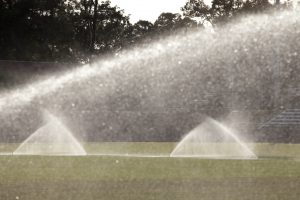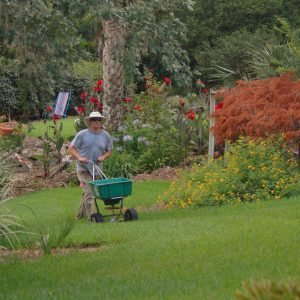The lawn is a staple when you picture the typical American home. It is where your kids play, where you stand to associate with your neighbors and the first impression you give to passers-by. It has also no doubt been a subject of frustration as you notice brown patches or open spots. Could this situation have been avoided in the first place? Lawn care is a topic we address in extension extensively. Proper maintenance practices will help your lawn be green and healthy providing you with years of enjoyment. Below are a few principles that if applied will help you avoid issues and grow a worry-free yard.
First Steps
Before you do anything else you will need to know what species you are working with. In this area we have warm season grasses with names like centipede and zoysia. Their individual characteristics will identify yours from the others. For instance, centipede grass is a lighter color with a course textured blade about 1/16 to 1/8 inches wide and a creeping habit as it spreads via stolon. This is very basic, as identifying grasses could be a day long course on its own. Knowing your lawn species will inform you as to mowing height and when periodic tasks such as dethatching may be necessary. All of these are necessities for a healthy lawn, but there are two universal tasks that need to be on the forefront of your mind.
Irrigation
Irrigation is arguably the most important topic in lawn care. Improper watering may cause your grass to die back opening bare spots for weeds and insects to infiltrate. Scheduled irrigation is not the best option. Your grass will tell you when it needs water. Look for indicators such as folding blades, color change, and lingering footprints as keys to irrigation. When you see these, apply ½ to ¾ inch of water preferably in the early morning. Take your soil type into consideration when watering as you will want this water in the root zone. Sandy soils may need a little more to saturate the area while clay may need to soak in through multiple applications. Watering only when required will encourage deeper rooting of your grass. So, how do you know how long to run your system? Calibrate your system by placing straight sided cans in your watering zones. Run the system until they fill to the desired level. The amount of time this takes will tell you how long you should run the system. While you are calibrating the system, take a look at where the sprinkler heads are aimed. Readjust any that place water in undesired locations like the street. Lastly, install a rain sensor. The Panhandle received an average 68.32 inches of rain in 2021*. There is no need to run your water system if mother nature is doing it for you.
*per FL Climate Survey https://climatecenter.fsu.edu/images/docs/Fla_Annual_climate_summary_2021.pdf
Fertilizing
Fertilization is another often misunderstood topic. Grass is a plant, and therefore requires nutrients to thrive. Over doing it in certain grasses may cause them to die back much like improper irrigation. Application rates vary by grass species and are given in terms of required nitrogen per 1000ft2 for a single growing season. You can tell how much Nitrogen a fertilizer has by looking at the first of the three-digit NPK rating. It indicates the amount by weight in the bag (8-8-8 = 0.08lbs nitrogen per 1lb fertilizer). Keep in mind that rate of fertilizer your grass needs is for the entire year. This means you will want to apply multiple times. So, if you need 13lbs of fertilizer it is best to apply about 4.33lbs three times across the growing season versus all at once. Only apply fertilizer during active growth. In the Panhandle this is mid-April through mid-September. Appropriate rates and timing will keep those expensive fertilizers in your root zone and not in our local waterways.
Appropriate care will provide lush healthy growth and a full lawn. Taking the time to identify your grasses will inform you as to what it needs to support your family for years to come. Appropriate irrigation and fertilization will in-turn support the health of local watersheds and potentially save you some money and effort. For more information on lawn maintenance, see these Ask IFAS documents, or contact your local extension agent for additional information on this and any topic regarding your gardens and more.
- Managing Storm Water in Landscapes - July 6, 2025
- It’s Time for Sweet Potatoes - May 22, 2025
- Ecological Benefit and Upkeep of Florida Lawns - April 21, 2025


